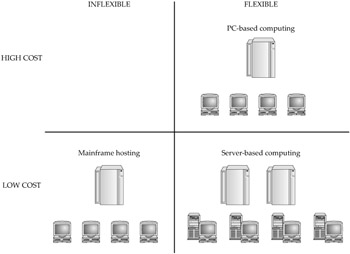Chapter 1: Introducing Server-Based Computing and the On-Demand Enterprise
|
Nearly 50 million workers in more than 120,000 customer organizations around the world use Citrix enterprise access infrastructure solutions every day. Access infrastructure is a category of enterprise software that consolidates previously separate types of access technologies in the areas of device and network services, aggregation and personalization, security and identity management, and presentation and conferencing. At the heart of access infrastructure is the server-based computing (SBC) model, which is the term we will use throughout this book. SBC utilizing Microsoft Terminal Services and the Citrix MetaFrame Access Suite is reshaping corporate computing by driving costs out of IT while increasing the utility and value of applications through universal (and controlled) access. In a 2002 in-depth research project, Giga Information Group determined that the average risk-adjusted payback for the firms participating in the study occurred within 11 months of deploying SBC on an enterprise scale. And while the economic justification for SBC alone is compelling, many organizations are transitioning to this architecture primarily to take advantage of other strategic benefits such as improved security, enhanced disaster recovery/business continuance, faster time to market, increased productivity, universal information access, regulatory compliance facilitation, and faster organizational growth.
In the 1990s, Citrix created the server-based computing category with the product now called Citrix MetaFrame XP Presentation Server, and then dramatically expanded its scope in March, 2003 with the introduction of the Citrix MetaFrame Access Suite. This suite enables organizations to utilize server-based computing on an enterprise scale to provide a geographically unrestrained and consistent user experience along with instant access to enterprise applications, information, people, and processes. The result is a single, integrated and consistent access infrastructure for the On-Demand Enterprise. This chapter introduces the concept of enterprise SBC. We consider the many economic benefits of SBC and the major industry trends that are accelerating its acceptance. We'll look at the four main functions of SBC solutions: application deployment, remote office connectivity, business continuity, and workforce mobility. We also consider other SBC advantages such as the ability to help facilitate compliance with government regulations and become more environmentally friendly. We analyze the main components of an enterprise SBC deployment, and discuss the process of designing an enterprise SBC environment, which we will build upon in the chapters that follow.
Enterprise SBC
Creating an on-demand enterprise built on access infrastructure and the SBC model enables IT departments to deliver software as a utility-like service. Benefits include ubiquitous access to the latest applications from any device across any connection. As with a regular utility, though, users are dependent upon a central source for delivering their service. If something happens to the network, users no longer can fall back to running applications locally. In this environment, building a robust, reliable, and scalable architecture is obviously essential. The data center(s) must operate similarly to mainframe shops, with stringent change control, controlled access, and well-defined policies and procedures such as rigorous offline testing of all new applications before their introduction into the production environment.
An SBC infrastructure has other similarities with the mainframe model of computing. For example, IT control of the desktop and application standards, reduced infrastructure costs, and much lower staffing requirements are attributes shared with the mainframe environment. Unlike the mainframe model, though, SBC users do not have to wait six months in an MIS queue in order to have IT produce a report for them. Instead, they can create it themselves in minutes by using Excel or any application to which IT gives them access.
SBC thus combines the best of both the mainframe and PC worlds. It incorporates the inexpensive desktop-computing cost structure of the mainframe model while allowing users the flexibility and versatility they are used to having with their PCs. The matrix in Figure 1-1 compares the cost and flexibility of SBC with both mainframe and PC-based computing.

Figure 1-1: SBC combines flexibility with low costs.
|
EAN: 2147483647
Pages: 158